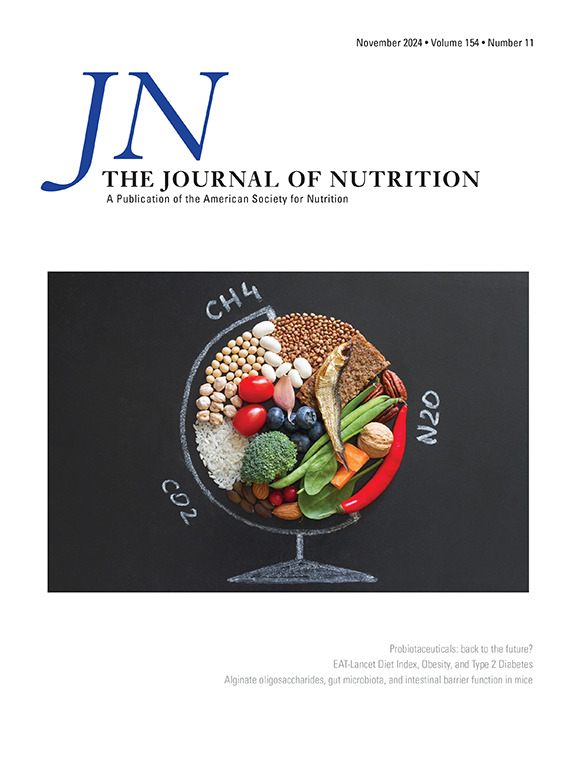Dietary Protein in a Challenge Meal Does Not Alleviate Postprandial Impairments in Vascular Endothelial Function in Healthy Older Adults with Cardiometabolic Risk: A Randomized Crossover-Controlled Trial
IF 3.7
3区 医学
Q2 NUTRITION & DIETETICS
引用次数: 0
Abstract
Background
Postprandial vascular endothelial dysfunction is an early marker of atherosclerosis. Meal protein has been reported to reduce endothelial dysfunction in adults, and the effect could be mediated by the amino acid content.
Objectives
This trial aims to assess the effect of a specifically designed plant-protein blend that contains high leucine, arginine, and cysteine on postprandial endothelial function in the elderly.
Methods
In a randomized, double-blind, 3-period crossover (2-wk washout), controlled trial, we compared the vascular effects of 3 high-saturated-fat high-sucrose (HFHS) meals containing either our specific plant-protein blend, or milk protein, or without added protein. The trial was conducted on 29 healthy adults aged >65 y presenting ≥2 cardiometabolic risk factors. Postprandial vascular function was evaluated at fasting, 3 h, and 5 h postprandially, using brachial flow-mediated dilation (FMD), hand microvascular reactivity (using Flowmetry Laser Doppler, FLD), and finger reactive hyperemia index (using Peripheral Arterial Tonometry, RHI). Immune cell count and gene expression in peripheral blood mononuclear cells (PBMCs) were also assessed postprandially. Data were analyzed using mixed linear models with repeated measurements on participants for meal composition and time of sampling. This trial was registered at clinicaltrials.gov as NCT04923555.
Results
FMD incremental AUC value decreased after meals (time effect P < 0.01), with no significant differences between meals. RHI also decreased with time (P < 0.01). PBMC count and monocyte chemoattractant protein-1 (MCP1), IL-1β, and IL-6 expression increased after meals showing postprandial endothelial activation (P < 0.05). Overall, meal composition had no effect on any of the postprandial changes (Ps>0.10).
Conclusions
In healthy adults aged >65 y presenting cardiometabolic risk, adding protein to an HFHS challenge meal does not mitigate postprandial impairments in vascular endothelial function and inflammatory activation. Further studies are needed to explore the potential differences with younger adults.
挑战餐中的膳食蛋白质不会减轻有心脏代谢风险的健康老年人餐后血管内皮功能的损伤:一项随机交叉对照试验。
背景:餐后血管内皮功能障碍是动脉粥样硬化的早期标志。据报道,餐蛋白质可减轻成年人的血管内皮功能障碍,其效果可能是由氨基酸含量介导的:本试验旨在评估含有大量亮氨酸、精氨酸和半胱氨酸的专门设计的植物混合蛋白对老年人餐后内皮功能的影响:在一项随机、双盲、3 期交叉(2 周冲洗)对照试验中,我们比较了 3 种高饱和脂肪高蔗糖(HFHS)膳食对血管的影响,这 3 种膳食分别基于我们特定的植物蛋白混合物、牛奶蛋白或不添加蛋白质。该试验针对 29 名年龄大于 65 岁、至少有两种心脏代谢风险因素的健康成年人。在空腹、餐后 3 小时和 5 小时时,使用肱动脉血流介导的扩张(FMD)、手部微血管反应性(通过流量计激光多普勒,FLD)和手指反应性充血指数(通过外周动脉测压,RHI)对餐后血管功能进行评估。餐后还对外周血单核细胞(PBMC)中的免疫细胞计数和基因表达进行了评估。数据采用混合线性模型进行分析,对参与者的膳食组成和采样时间进行重复测量。该试验在 clinicaltrials.gov 登记为 NCT04923555:结果:餐后 FMD iAUC 下降(时间效应 P0.10):结论:对于 65 岁以上有心脏代谢风险的健康成年人,在高血脂挑战餐中添加蛋白质并不能减轻餐后血管内皮功能和炎症激活的损伤。需要进一步研究探讨与年轻成年人的潜在差异。
本文章由计算机程序翻译,如有差异,请以英文原文为准。
求助全文
约1分钟内获得全文
求助全文
来源期刊

Journal of Nutrition
医学-营养学
CiteScore
7.60
自引率
4.80%
发文量
260
审稿时长
39 days
期刊介绍:
The Journal of Nutrition (JN/J Nutr) publishes peer-reviewed original research papers covering all aspects of experimental nutrition in humans and other animal species; special articles such as reviews and biographies of prominent nutrition scientists; and issues, opinions, and commentaries on controversial issues in nutrition. Supplements are frequently published to provide extended discussion of topics of special interest.
 求助内容:
求助内容: 应助结果提醒方式:
应助结果提醒方式:


